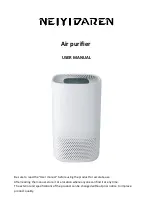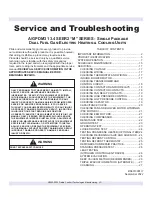
Startup
RT-SVX34F-EN
49
Constant Volume or Variable Air
Volume Applications (Single Zone
or Traditional)
Off Mode
This mode is set at the zone sensor or by ICS. During this
status, no heating, ventilation, or mechanical cooling is
being performed. When switching the “System” selector
to the “Off” mode from any other mode, any diagnostic
data and diagnostic indication signal will be retained as
long as the system remains in the “Off” status. Switching
the “System” selector from the “Off” mode back to any
other mode of operation will reset all diagnostics.
Zone Temperature - Unoccupied Cooling
(CV or SZ VAV Only)
While a building is in an unoccupied period as designated
by a remote panel with night setback, ICS or RTRM J6-11
and J6-12, the necessary cooling capacity will be
controlled to maintain the zone temperature to within the
unoccupied setpoint deadband. If an economizer is
enabled, it will modulate in an attempt to maintain the
zone temperature to within the setpoint deadband.
Note:
On SZ VAV units, the Supply Air Fan Speed will be
controlled as during normal occupied conditions in
order to meet the requirements of the zone.
Unoccupied mode does not require full airflow on
a SZ VAV unit during Cooling operation.
Zone Temperature - Unoccupied Heating
While a building is in an unoccupied period as designated
by a remote panel with night setback or ICS, the necessary
heating capacity will be controlled to maintain the zone
temperature to within the unoccupied setpoint deadband.
For traditional VAV systems, the VFD will operate at 100%
during this mode. It will be necessary to drive VAV boxes
to their maximum position through ICS programming or
the factory provided VHR relay. For SZ VAV systems, the
Supply Air Fan VFD will remain in control as during normal
occupied periods and will be controlled in order to meet
the space requirements. The minimum fan speed will be
based on the configured unit heating type. For Modulating
Heat units, Full Airflow is not required for SZ VAV
applications during Unoccupied periods. For all Staged
Heating types, the Supply Fan will be controlled at
maximum fan speed during active heating operation as
during Occupied periods.
Mechanical Cooling with an Economizer
The economizer is utilized to control the zone temperature
when the outside air conditions are suitable. The method
used to determine economizer effectiveness, depending
on the available data, is described below in descending
order of complexity. The most sophisticated method
available is always used.
Two of the three methods for determining the suitability of
the outside air can be selected utilizing the potentiometer
on the Economizer Actuator, as described below:
1.
Ambient Temperature - controlling the economizing
cycle by sensing the outside air dry bulb temperature.
Table 25
lists the selectable dry bulb values by
potentiometer setting.
2. Reference Enthalpy - controlling the economizer cycle
by sensing the outdoor air humidity.
Table 25
lists the
selectable enthalpy values by potentiometer setting. If
the outside air enthalpy value is less than the selected
value, the economizer is allowed to operate.
3. Comparative Enthalpy - By utilizing a humidity sensor
and a temperature sensor in both the return air stream
and the outdoor air stream, the economizer will be able
to establish which conditions are best suited for
maintaining the zone temperature, i.e., indoor
conditions or outdoor conditions.
Gas Heat Control
The ignition sequence and timing are provided by a
separate heat control module. The RTRM only provides
the heating outputs to initiate 1st and 2nd stages and
control the combustion blower relays. Both stages of the
furnace, when initiated after each cycle, will start and
operate for one minute then cycle back if only one stage is
required. Units with modulating heat capabilities will light
on high fire for one minute and then modulate to the
appropriate heating rate for the building load present.
When the fan selection switch is in the “AUTO” mode and
the unit is configured as a Constant Volume with staged or
modulating gas heat, or SZ VAV with staged gas heat, the
fan will be delayed from coming on for approximately 30
seconds after a call for heat has been initiated. The fan will
remain on for approximately 90 seconds after the heating
setpoint has been satisfied. If the unit is configured for SZ
Table 24. Economizer effectiveness
Method used to
determine economizer
effectiveness
Required
Comparative Enthalpy
OAT, OAH, RAT, RAH
Reference Enthalpy
OAT, OAH
Reference Dry Bulb
OAT
Unable to determine
effectiveness
OAT data is invalid or
unavailable
Table 25. Economizer configuration
Selection
Dry Bulb
Enthalpy Value
A
73°F
27 BTU/LB Air
B
70
25 BTU/LB Air
C
67
23 BTU/LB Air
D
63
22 BTU/LB Air
E
55
19 BTU/LB Air
















































